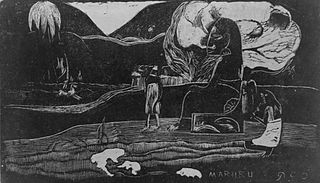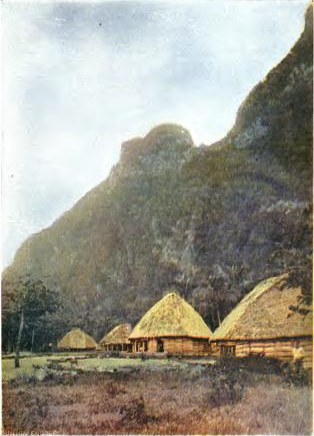Related Research Articles

Hina is the name assigned to a number of Polynesian deities. The name Hina usually relates to a powerful female force who has dominion over a specific entity. Some variations of the name Hina include Sina, Hanaiakamalama, and Ina. Even within a single culture, Hina could refer to multiple goddesses and the distinction between the different identities are not always clear. In Hawaiian mythology, the name is usually paired with words which explain or identify the goddess and her power such as Hina-puku-iʻa (Hina-gathering-seafood) the goddess of fishermen, and Hina-ʻopu-hala-koʻa who gave birth to all reef life.
In Polynesian languages the word aitu refers to ghosts or spirits, often malevolent. The word is common to many languages of Western and Eastern Polynesia. In the mythology of Tonga, for example, ʻaitu or ʻeitu are lesser gods, many being patrons of specific villages and families. They often take the form of plants or animals, and are often more cruel than other gods. These trouble-making gods are regarded as having come from Samoa. The Tongan word tangi lauʻaitu means to cry from grief, to lament.
In the traditions of ancient Hawaiʻi, Kanaloa is a god symbolized by the squid or by the octopus, and is typically associated with Kāne. It is also an alternative name for the island of Kahoʻolawe.
Pulotu is the resting place of those passed on in the Polynesian narrative of Tonga and Samoa, the world of darkness "lalo fonua".
In Samoan mythology, Tagaloa is generally accepted as the supreme ruler, the creator of the universe, the chief of all gods and the progenitor of other gods. Tagaloa Lagi dwelt in space and made the Heavens the sky, the land, the seas, the fresh water, the trees and the people. Samoans believed Tagaloa created nine heavens. Tagaloa's role as paramount deity in the Samoa pantheon bears similarities to the position of Ta'aroa in Tahiti and Io Matua Kore in Aotearoa New Zealand.

Savaiʻi is the largest and highest island both in Samoa and in the Samoan Islands chain. The island is also the sixth largest in Polynesia, behind the three main islands of New Zealand and the Hawaiian Islands of Hawaii and Maui. While it is larger than the second main island, Upolu, it is significantly less populated.

Falealupo is a village in Samoa situated at the west end of Savai'i island 20 miles (32 km) from the International Date Line used until 29 December 2011. The village has two main settlements, Falealupo-Uta, situated inland by the main island highway and Falealupo-Tai, situated by the sea. The road to the coastal settlement is about 9 km, most of it unsealed, from the main highway. The village's population is 545.

Ātua is an ancient political district of Samoa, consisting of most of the eastern section of Upolu and the island Tutuila. Within Samoa’s traditional polity, Ātua is ruled by the Tui Ātua together with the group of six senior orators of Lufilufi and 13 senior matai from throughout Ātua, comprising the Fale Ātua. The fono (meeting) of Atua's rulers takes place in Lufilufi on the great malae of Lalogafu'afu'a.

Nafanua was a historical ali'i (chief/queen) and toa (warrior) of Samoa from the Sā Tonumaipe'ā clan, who took four pāpā (district) titles, the leading ali'i titles of Samoa. After her death she became a goddess in Polynesian religion.

The islands of Samoa were originally inhabited by humans as early as 850 BC. After being invaded by European explorers in the 18th century, by the 20th and 21st century, the islands were incorporated into Samoa and American Samoa.
Matautu is the name of different villages in Samoa. Places named Matautu are found on the two largest islands, Upolu and Savaiʻi.

Safune is a traditional village district on the central north coast of Savai'i island in Samoa. It lies within the electoral constituency of Gaga'ifomauga. Safune is the birthplace of Mau leader Olaf Frederick Nelson and the filming location of Moana, one of the first documentaries made in the world. The Mata o le Alelo pool associated with the Sina and the Eel Polynesian legend is also in Safune.
Pili line was a royal house in ancient Hawaii that ruled over the island of Hawaiʻi with deep roots in the history of Samoa and possibly beyond further to the west, Ao-Po, in Pulotu, the Samoan Underworld. It was founded on unknown date by King Pilikaʻaiea (Pili), who either was born in or came from either Upolu, Samoa or Uporu, Tahiti, but came to Hawaii and established his own dynasty of kings (Aliʻi). The overall arc of his career describes a brilliant young chief from foreign lands who was eager to share his abundant knowledge of advanced technology with distant frontier rustics. Some stories relate how his ambition got the better of him and damaged his relationships with his subjects. These stories cast him as a libidinous, restless and petty tyrant ever on the move searching for new conquests.
According to a legend in Samoan mythology Tilafaiga was one of the twin sisters who brought the art of tatau to Samoa from Fitiuta in Manu’a. Tilafaiga's twin sister's name is Taema.
Saveasiʻuleo is the God of Pulotu the underworld of spirits or Hades in Samoan mythology.

Fagamalo is a village situated on the central north coast of Savai'i in Samoa. It is a sub-village or pito nu'u of the larger traditional village enclave of Matautu in the political district of Gaga'emauga. The population of the village is 383.

Sina and the Eel is a myth of origins in Samoan mythology, which explains the origins of the first coconut tree.
Tui Fiti or Tuifiti is the name of a figure referred to in different legends in Samoan mythology and in other parts of Polynesia. In other stories, "Tui Fiti" means "high chief of Fiti."
Taema is the name of a female figure referred to in different legends in Samoan mythology.

Tuvaluan mythology tells stories of the creation of the islands of Tuvalu and of the founding ancestors of each island. While on some of the islands there are stories of spirits creating the islands, a creation story that is found on many of the islands is that te Pusi mo te Ali created the islands of Tuvalu; te Ali is believed to be the origin of the flat atolls of Tuvalu and te Pusi is the model for the coconut palms that are important in the lives of Tuvaluans. The strength of this belief has the consequence that Moray eel are tapu and are not eaten.
References
- ↑ Philip Culbertson; Margaret Nelson Agee; Cabrini 'Ofa Makasiale (2007). Penina Uliuli: Contemporary Challenges in Mental Health for Pacific Peoples. p. 68. ISBN 9780824832247 . Retrieved 2016-04-12.
- ↑ "History of Samoa". Archived from the original on February 18, 2012. Retrieved September 21, 2009.
- ↑ George Turner (October 2006). Samoa, a Hundred Years Ago and Long Before. p. 123. ISBN 9781406833713 . Retrieved 2016-04-12.
- ↑ "Marcellin College - Sina and the Eel". Living Heritage. Retrieved 2016-04-12.
- ↑ Knappert, Jan (1992). Pacific Mythology: An Encyclopedia of Myth and Legend. Aquarian Press. pp. 14, 78. ISBN 1855381338.
